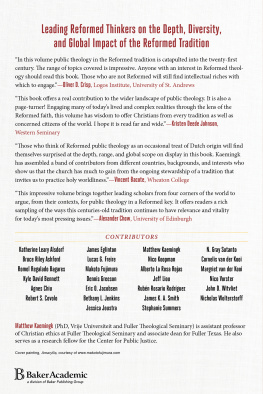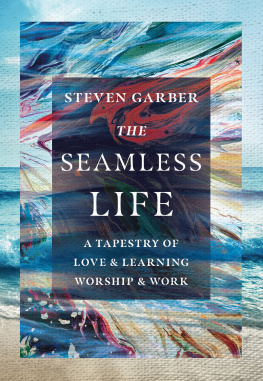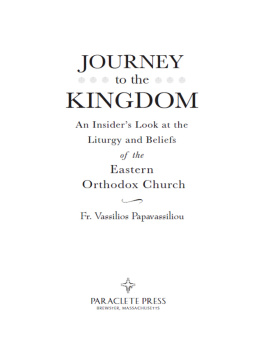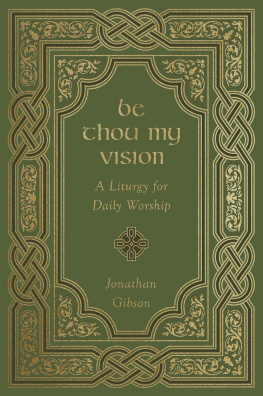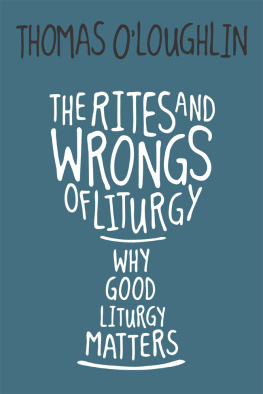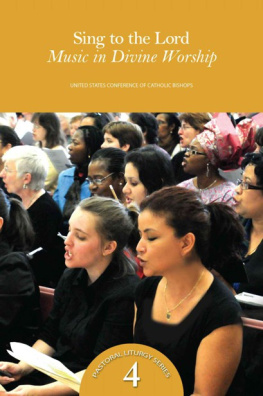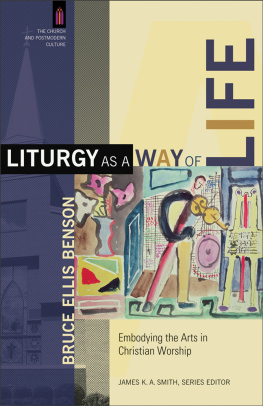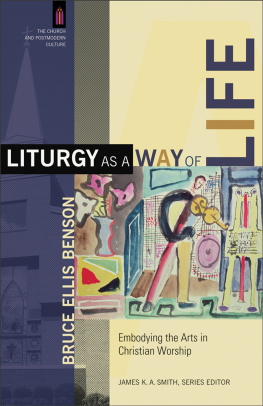Matthew Kaemingk - Work and worship : reconnecting our labor and liturgy
Here you can read online Matthew Kaemingk - Work and worship : reconnecting our labor and liturgy full text of the book (entire story) in english for free. Download pdf and epub, get meaning, cover and reviews about this ebook. year: 2020, genre: Romance novel. Description of the work, (preface) as well as reviews are available. Best literature library LitArk.com created for fans of good reading and offers a wide selection of genres:
Romance novel
Science fiction
Adventure
Detective
Science
History
Home and family
Prose
Art
Politics
Computer
Non-fiction
Religion
Business
Children
Humor
Choose a favorite category and find really read worthwhile books. Enjoy immersion in the world of imagination, feel the emotions of the characters or learn something new for yourself, make an fascinating discovery.
- Book:Work and worship : reconnecting our labor and liturgy
- Author:
- Genre:
- Year:2020
- Rating:4 / 5
- Favourites:Add to favourites
- Your mark:
- 80
- 1
- 2
- 3
- 4
- 5
Work and worship : reconnecting our labor and liturgy: summary, description and annotation
We offer to read an annotation, description, summary or preface (depends on what the author of the book "Work and worship : reconnecting our labor and liturgy" wrote himself). If you haven't found the necessary information about the book — write in the comments, we will try to find it.
Work and worship : reconnecting our labor and liturgy — read online for free the complete book (whole text) full work
Below is the text of the book, divided by pages. System saving the place of the last page read, allows you to conveniently read the book "Work and worship : reconnecting our labor and liturgy" online for free, without having to search again every time where you left off. Put a bookmark, and you can go to the page where you finished reading at any time.
Font size:
Interval:
Bookmark:
Values at Play in Digital Games
Values at Play in Digital Games
Mary Flanagan and Helen Nissenbaum
The MIT Press
Cambridge, Massachusetts
London, England
2014 Massachusetts Institute of Technology
All rights reserved. No part of this book may be reproduced in any form by any electronic or mechanical means (including photocopying, recording, or information storage and retrieval) without permission in writing from the publisher.
Library of Congress Cataloging-in-Publication Data
Flanagan, Mary, 1969
Values at play in digital games / Mary Flanagan and Helen Nissenbaum.
pages cm
Includes bibliographical references and index.
ISBN 978-0-262-02766-3 (hardcover : alk. paper)
ISBN 978-0-262-32445-8 (retail e-book)
1. Computer gamesSocial aspects. 2. Values. 3. Digital mediaSocial aspects. 4. Computer gamesDesign. I. Nissenbaum, Helen Fay. II. Title.
GV1469.17.S63F63 2014
794.8dc23
2013043220
10 9 8 7 6 5 4 3 2 1
Acknowledgments
This book and Values at Play reflect many years of research and explorationfrom the start of the Values at Play project in 2005 to the final stroke of editing. Never alone in these endeavors, we benefitted from the support, brilliance, intellectual generosity, and attention of others. As ideas unfolded, we were afforded invaluable opportunities to try them out with audiences of scholars and researchers, with expert gamers as well as the newly initiated, with accomplished designers as well as the eager novice. Our ideas were shaped by their insights, comments, and criticisms, often in ways that are impossible to discern but, here, we wish to acknowledge.
For material and financial support we are grateful for a grant from the National Science Foundations Science of Design program for our collaborative project: Values at PlayIntegrating Social Factors into Design (CNS 0613893), awarded September 2006. Other NSF grants that supported crucial aspects of the Values at Play model include the Cyber-Trust (CT) Collaborative award: CT-M: Privacy, Compliance and Information Risk in Complex Organizational Processes (CNS-0831124), and an EAGER award: Values in Design in the Future Internet Architecture (CNS/NetS 1058333). The bias games discussed in chapter 5 emerged from an EAGER award, Transforming STEM for Women and Girls: Reworking Stereotypes and Bias (HRD-1137483), awarded September 2011. The Intel Science and Technology Center for Social Computing has provided a fertile environment as well as financial support enabling the writing and completion of the manuscript. A grant from the Lady Davis Fellowship Trust, supported a sabbatical semester as a Visiting Professor at the Hebrew University of Jerusalem, Department of Communication and Journalism, and allowed uninterrupted time to work on the manuscript. Mary Flanagan is grateful for Dartmouth College support in her role as the Sherman Fairchildnamed chair.
Conferences and universities where weve grown games with Grow-a-Game include: Games for Change NYC; Different Games; IndieCade; Technology for Peace; Playing for Change UK; Grassroots Media Conference; the Game Developers Conference; Games, Learning, and Society; the Digital Games Research Association; the Virtual 2006 conference; and the ACM CHI conference. We gratefully acknowledge audience comments at the University of Pennsylvanias Annenberg School for Communication Colloquium, the Digital Humanities Center and Department of Philosophy Colloquium at Dartmouth University, the University of Illinois at Urbana-Champaigns, Information Trust Institute Lecture, the International Conference of Computer Ethics at Ionian University, Corfu, Greece, the Information Science Program Colloquium at Cornell University, a lecture hosted by the Humanities Center at Carnegie-Mellon University, and a lecture at the Center for International Education at University of WisconsinMilwaukee, among others. Students in Nissenbaums Values in Technology classes at NYU (Media, Culture and Communication) have wrestled with iterations of Values at Play and along the way inspired improvements.
The Values in Design Summer PhD workshops held in 2008 at Santa Clara University and in 2010 at New York University, in collaboration with Geof Bowker and the late Susan Leigh Star, were exciting venues for presenting Values at Play. Participants wholeheartedly engaged with theory and methodology, contributed GAG card games and ideas that have influenced our thinking to this day.
The book owes an enormous debt to past collaborative and coauthored works, most significantly, those with Daniel Howe, Jonathan Belman, and James Diamond, which contributed to the formation of both the theory and structure of Values at Play as well as its pedagogical and design applications. Jonathan Belman was a contributor on chapter 3 in this book and helped dig up examples throughout. Christopher Egert was author of the original Grow-a-Game digital deck, and Jack Boffa programmed Grow-a-Game for iPhone.
We offer special thanks to the amazing VAP Advisory Board: Katie Salen, Frank Lantz, Tracy Fullerton, Celia Pearce, Jesper Juul. Many exciting conversations, including challenging and supportive insights, inspired us and shaped our work. Several of these advisors wrote short sections in the book, and in addition we welcome the work of Karen Schrier and Kyle Rentschler.
For outstanding research and editorial work, thanks to Emily Goldsher-Diamond, Kyle Rentschler, Toni Pizza, and Mark Essig. Their superhuman efforts at every stage of the book propelled us forward and kept us going. To our rock-star acquisitions editor, Doug Sery, thanks for your faith and enthusiasm. To anonymous reviewers of the final draft, to Deborah Cantor-Adams of the editorial staff, and to the production staff at the MIT Press, we are deeply grateful for helping us to produce a better book.
Gratitude to key members of our research teams: Sukdith Punjasthitkul, Max Seidman, Anna Lotko, Zara Downs, Suyin Looui, James Bachhuber, John Fanning, Brian Mayzak, Greg Kohl, Jarah Moesch, Jennifer Jacobs, Vanessa Moy, Geoff Kaufman, Danielle Taylor, Grace Peng, Paul Orbell, Chris Takeuchi, Brendan Scully.
Friends, colleagues, comrades, and supporters: Jeff Watson, Naomi Clark, Drew Davidson, Doris Rusch, JoEllen Fisherkeller, Brian Myzak, Angela Ferraiolo, Jose Zagal, Lindsay Gupton, Katherine Isbister, Suzanne Seggerman, Ben Stokes, Suzanna Ruiz, Alice Bonvicini, Zsuzanna Mitro, and the fine folks at Furtherfield.
Thanks for ongoing inspiration from the VID community, and in particular Geof Bowker, Paul Dourish, Batya Friedman, Cory Knobel, Phoebe Sengers, and Michael Zimmer.
Important thanks go to the designers who shared their powerful stories with us for this book.
We are grateful to several organizations for using our methods and contributing to their iterative improvement: Mouse, WQED, Design Studio for Social Intervention Youth Activism Design Institute (YADI), RMITs GEElab, and the Salzburg Global Seminars.
The significant people in our livesfriends and familysupport, nourish, and balance us in indescribable but essential ways. This book is a tribute to them.
MF: I dedicate this book to my family, avid game players one and all, and in particular to my mother, Rose Flanagan, who encouraged early entry to worlds of play.
HN: To my dear family Peter, Dana, Zoe, and Ann Sarnak, thank you for keeping me focused on important things. I dedicate this book to my mother, Rose Nissenbaum, who passed away in August 2013. She was a consummate player of gamesa fierce yet fair competitor.
Introducing Values at Play
In 2007, the video game developer BioWare released Mass Effect, a role-playing game that contains short flashes of sexual activity toward the end of the game. The game allows players to watch the sex but not to play through the sex, and the scenes are less explicit than many that can be found on network television shows. The relationships between the characters develop over time, there is no complete frontal nudity, and the sex scenes occupy around two minutes of a thirty-hour experience.
Next pageFont size:
Interval:
Bookmark:
Similar books «Work and worship : reconnecting our labor and liturgy»
Look at similar books to Work and worship : reconnecting our labor and liturgy. We have selected literature similar in name and meaning in the hope of providing readers with more options to find new, interesting, not yet read works.
Discussion, reviews of the book Work and worship : reconnecting our labor and liturgy and just readers' own opinions. Leave your comments, write what you think about the work, its meaning or the main characters. Specify what exactly you liked and what you didn't like, and why you think so.


